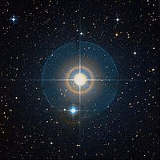
Xi Scorpii
Encyclopedia
Xi Scorpii is a star system
in the constellation
Scorpius
. It was also 51 Lib
.
The Xi Scorpii system consists of at least five stars in two groups separated by 4.67 arcminutes (or 0.08°) on the sky, corresponding to a distance of at least 8000 astronomical units (AU).
The brighter group contains Xi Scorpii A, B, and C. A and B are both yellow-white F-type
stars. A is a slightly brighter and warmer magnitude
+4.8 subgiant, while B is a magnitude +5.1 main sequence
dwarf. They are separated by 0.76 arcseconds, or at least 21 AU, roughly a Sun
–Uranus
distance, and orbit around a common centre once every 46 years. The magnitude +7.6 Xi Scorpii C orbits this pair at ten times the distance, having a separation of 7.6 arcseconds.
The second group contains Xi Scorpii D and E. Both D and E are K-type
stars, which are separated by 11.5 arcseconds, more than 320 AU.
Xi Scorpii also possesses a sixth component,
the 11th magnitude Xi Scorpii F, located 81 arcseconds from D. It is not known to be gravitationally
bound to the other five components.
Star system
A star system or stellar system is a small number of stars which orbit each other, bound by gravitational attraction. A large number of stars bound by gravitation is generally called a star cluster or galaxy, although, broadly speaking, they are also star systems.-Binary star systems:A stellar...
in the constellation
Constellation
In modern astronomy, a constellation is an internationally defined area of the celestial sphere. These areas are grouped around asterisms, patterns formed by prominent stars within apparent proximity to one another on Earth's night sky....
Scorpius
Scorpius
Scorpius, sometimes known as Scorpio, is one of the constellations of the zodiac. Its name is Latin for scorpion, and its symbol is . It lies between Libra to the west and Sagittarius to the east...
. It was also 51 Lib
Libra (constellation)
Libra is a constellation of the zodiac. Its name is Latin for weighing scales, and its symbol is . It is fairly faint, with no first magnitude stars, and lies between Virgo to the west and Scorpius to the east.-Notable features:]...
.
The Xi Scorpii system consists of at least five stars in two groups separated by 4.67 arcminutes (or 0.08°) on the sky, corresponding to a distance of at least 8000 astronomical units (AU).
The brighter group contains Xi Scorpii A, B, and C. A and B are both yellow-white F-type
Stellar classification
In astronomy, stellar classification is a classification of stars based on their spectral characteristics. The spectral class of a star is a designated class of a star describing the ionization of its chromosphere, what atomic excitations are most prominent in the light, giving an objective measure...
stars. A is a slightly brighter and warmer magnitude
Apparent magnitude
The apparent magnitude of a celestial body is a measure of its brightness as seen by an observer on Earth, adjusted to the value it would have in the absence of the atmosphere...
+4.8 subgiant, while B is a magnitude +5.1 main sequence
Main sequence
The main sequence is a continuous and distinctive band of stars that appears on plots of stellar color versus brightness. These color-magnitude plots are known as Hertzsprung–Russell diagrams after their co-developers, Ejnar Hertzsprung and Henry Norris Russell...
dwarf. They are separated by 0.76 arcseconds, or at least 21 AU, roughly a Sun
Sun
The Sun is the star at the center of the Solar System. It is almost perfectly spherical and consists of hot plasma interwoven with magnetic fields...
–Uranus
Uranus
Uranus is the seventh planet from the Sun. It has the third-largest planetary radius and fourth-largest planetary mass in the Solar System. It is named after the ancient Greek deity of the sky Uranus , the father of Cronus and grandfather of Zeus...
distance, and orbit around a common centre once every 46 years. The magnitude +7.6 Xi Scorpii C orbits this pair at ten times the distance, having a separation of 7.6 arcseconds.
The second group contains Xi Scorpii D and E. Both D and E are K-type
Stellar classification
In astronomy, stellar classification is a classification of stars based on their spectral characteristics. The spectral class of a star is a designated class of a star describing the ionization of its chromosphere, what atomic excitations are most prominent in the light, giving an objective measure...
stars, which are separated by 11.5 arcseconds, more than 320 AU.
Xi Scorpii also possesses a sixth component,
the 11th magnitude Xi Scorpii F, located 81 arcseconds from D. It is not known to be gravitationally
bound to the other five components.

